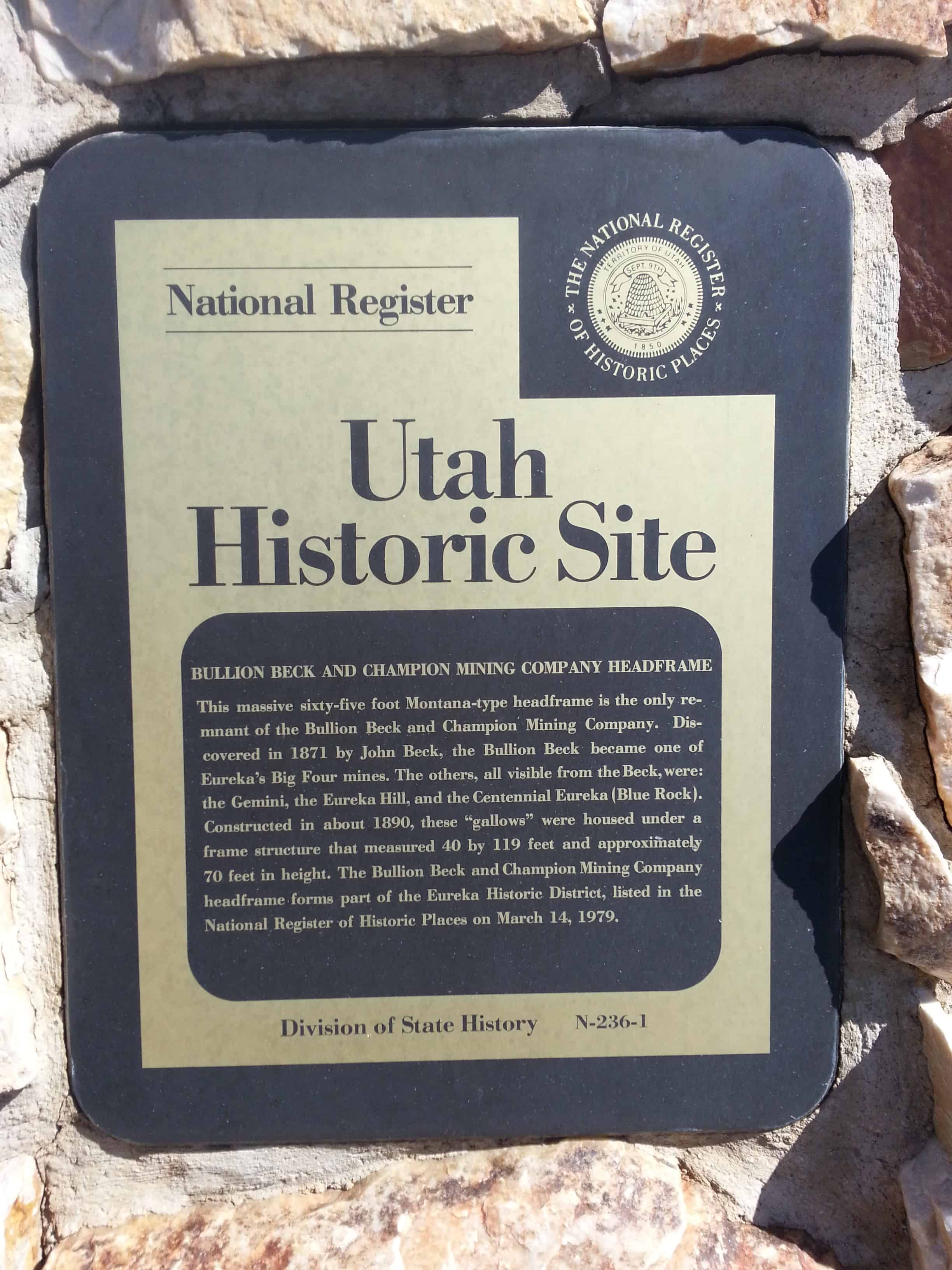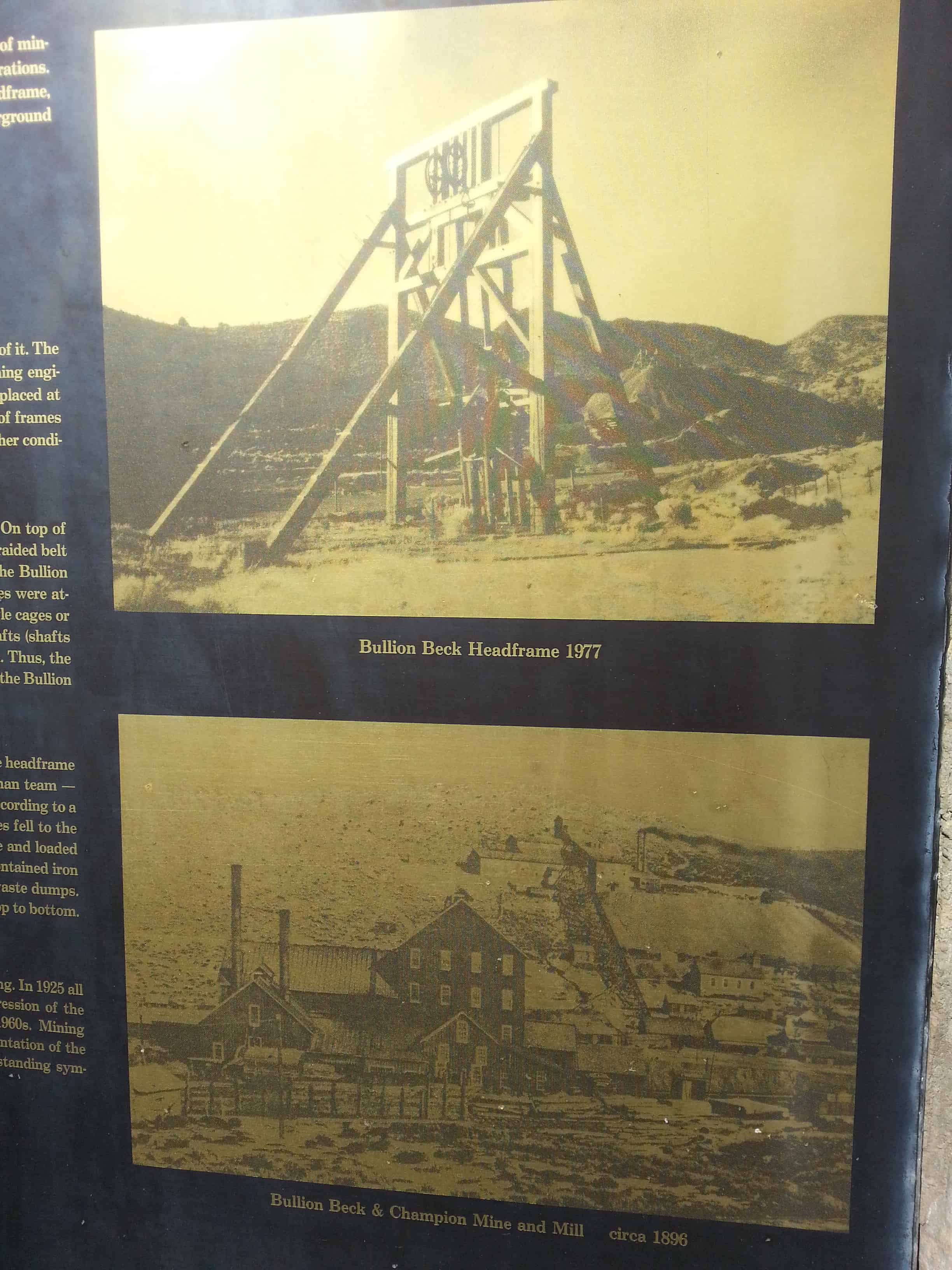Tags
Eureka, Juab County, Mines, Mining, NRHP, Silver City, utah
BULLION BECK AND CHAMPION MINING COMPANY HEADFRAME
This massive sixty-five Montana type Headframe is the only remnant of the Bullion Beck & Champion Mining Company. Discovered in 1871 by John Beck, the Bullion Beck became one of Eureka‘s big four mines. The others, all visible from the Beck, were the Gemini, the Eureka Hill, and the Centennial Eureka or Blue Rock. Constructed in about 1890 these gallows were housed under a frame structure that measured 40 x 119 feet and approximately 70 feet in height. The Bullion Beck & Champion Company Headframe forms part of the Eureka Historic District listed in the National Register of Historic Places on March 14, 1979.
THE BULLION BECK & CHAMPION MINING COMPANY HEADFRAME
Perched over deep mining shafts, headframes or gallows frames illustrate the development of mining from small individually owned prospects to the large- scale operation of mining corporations. Technological innovations were required to accomplish this change. The Bullion Beck headframe, constructed in 1890, served to transport men, mules, supplies, and ore in and out of the underground workings. “The Salt Lake Tribune”, January 1, 1891, described the newly constructed plant:
Over the shaft is a main building of hoisting works. This is a substantially-framed structure, 40 x 119 feet, and high enough to take in the gallows frame, that being one of the best and strongest in the country and 60 feet in height. There are no better frame timbers or larger ones than these in Utah.
Headframes were of various types- the 4- or 6-post type and the A-type or modifications of it. The Bullion Beck gallows is A-type, also called two-post headframe or Montana type. Mining engineers’ handbook contains stress sheets and diagrams that illustrate how all bracing was placed at angles and in positions designed to hold the weight and stress needed to do the job. Sizes of frames depended on load weight, shaft size and depth, special equipment requirements, and weather conditions if exposed.
The Headframe allowed mining from depths of 300 to over 3,000 feet below the surface. On top of this frame sits sheaves, large wheels over which ran the hoisting rope. The rope, first a braided belt then a wire cable, ran from the hoisting engines some distance from the headframe. Bullion Beck had two Frazer and Chalmers 500 horse-power engines. The ropes from the sheaves were attached to cages that traveled in and out of the vertical shaft. These could have single cages or double-decked and had sections of track attached for rolling in ore cars. In inclined shafts (shafts descending at an angle) all self-dumping ore cars with wheels called skips were used. Thus, the vertical beams running in the center of the frame are often labeled skip guides. Those of the Bullion Beck were partially reconstructed in 1987.
Hoisting was the process of getting men, equipment, and ore in and out of the mine. The headframe served as part of the hoisting plant or works. Basically, the process involved a three-man team – hoist operator, top lander and cage tender. The hoist operator ran the hoisting engine according to a set system of bell signals. Removing loaded ore cars and sending down the empty ones fell to the top lander, while the cage tender delivered the loads to the different levels of the mine and loaded cars of ore or overburden to be sent to the surface. The floor at the top of the shaft contained iron plates and tracks for the cars so that they could be sent to the ore bins or to the waste dumps. Bullion Beck Mine contained a double compartment shaft with a man-way from top to bottom. The timber-lined shaft collar is now covered.
The surface plant of the Bullion Beck Mine was originally enclosed in a wooden building. In 1925 all of the plant was demolished except the headframe, which sat idle during the depression of the 1930s. It reopened due to World War II demand and operated into the early 1960s. Mining historians view the headframe as “the most prominent feature in almost any representation of the ordinary mine of the frontier period.” These wooden gallows are very rare. Those standing symbolize the important of the western mining landscape.

























Pingback: Eureka, Utah (originally “Ruby Hollow”) | JacobBarlow.com